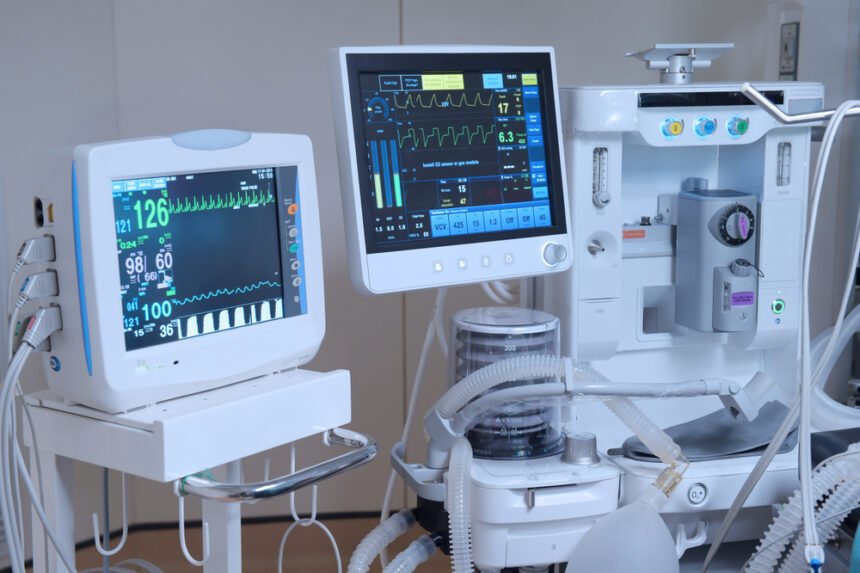- Why Medical Devices May Cause Price Increases — (It Is Not What You Think)
- Logistics Is Slowly Becoming a High Priority
- Increasing Cybersecurity in Medical Devices Is Necessary
- Other Unnoticed Reasons Why Healthcare Costs Are Astronomical
- Some Providers May Be to Blame
- Chronic Disease Plays a Part
- Big Pharma Takes Advantage of Capitalism and Legal Loopholes
- Wasted Medical Supplies
- How Medical Devices Can Be a Solution for the Skyrocketing Healthcare Costs
- Medical Devices Can Provide Eco-Friendly Alternatives
- Medical Device Accessories
- Medical Devices Affect Workflow
- Final Thoughts on Medical Devices
- Summary
Healthcare costs are on the rise; according to CNN Money, a 2016 report reveals the huge cost gap between the early 2000s and now, a decade or so later. The report specifically reveals that the average deductible for a single-coverage health care plan in 2006 cost $747, compared to a whopping $1,221 in 2016 (a $474 difference).
The same report showed the harsh financial realities several American families face; in 2016, the average family healthcare plan cost $18,142, which is 3.4% higher than what is was the year prior. Going by the numbers, it will not be surprising to see these figures increase come 2018, let alone the last months of 2017.
While families can cut healthcare costs by choosing generic over brand medicines and consider urgent care versus the emergency room in non-critical situations, medical devices may be able to cut some healthcare costs—not just for providers but indirectly for patients as well (due to some providers potentially passing on the costs to the patients’ bills).
However, the solution to the exorbitant healthcare costs is not so cut and dry; while, in some cases, medical devices may help reduce costs, in others it may increase it.
That said, we will explore the ins and outs of medical devices: the reasons why healthcare costs are so high, and if medical devices are a solution or a hindrance, plus more.
Why Medical Devices May Cause Price Increases — (It Is Not What You Think)
While medical devices can improve workflow and have helped some medical facilities cut electrical costs, it does contribute to the hike in healthcare costs. However, it is now that you think.
Logistics Is Slowly Becoming a High Priority
Medical device manufacturers are more concerned with designing and innovating the products and making sure they are safe than on how best to ship them.
In other words, logistics is one of the last things medical device companies are thinking about—largely because, according to Modern Healthcare, there is little incentive for them to do so. This means, the article goes on to state, that the medical products may be shipped in less than a day…in the sales person’s trunk.
Because of inefficient logistics, providers pay more for the medical products. However Modern Health states hospitals are working with medical device companies to figure out the best logistical situation possible.
Increasing Cybersecurity in Medical Devices Is Necessary
According to Wired, a December investigation, led by British and Belgian researchers, revealed security flaws in proprietary communications in 10 new-generation implantable cardiac defibrillators (ICD) that are on the market. This is cause for concern since hackers can take advantage of such vulnerabilities. What is especially disturbing is that the consequences are much more devastating than identity theft, a non-functional computer, or even financial damages. We are talking about a person’s physical body and health.
Medical devices currently on the market need to bolster their security methods, let alone manufacturers need to have an incentive to put them there and not rely on third party components in the first place, as Wired reports.
Nonetheless, while it is best for medical device manufacturers to adopt the National Institute of Standards and Technology (NIST) framework, the time taken for them to increase security efforts would likely increase time to market and increase cost-to-market costs.
Still, even factoring in cyber security and logistical costs, medical devices are not the only contributing factor, as providers, chronic disease, Big Pharma, and medical supply waste are some reasons to also consider.
Other Unnoticed Reasons Why Healthcare Costs Are Astronomical
It is easy to pin the rising healthcare costs on slow or inadequate legislature, however, how healthcare got so expensive is (unfortunately) more multifaceted than that.
Some Providers May Be to Blame
First off, unlike retail or food service companies where consumers can choose to buy an article of clothing or meal, diabetic patients cannot decide to stop taking their insulin shots and patients suffering from an aggressive allergy attack cannot choose to forgo using the epi pen.
Long story short, patients need to visit the doctor, take their medicine, and continue their course of treatment, as not doing so could be life-threatening.
Consequently (and sadly), some providers take advantage of this predicament, jacking prices as high as the market allows them to be.
Chronic Disease Plays a Part
As the Harvard Business Review indicates, Americans are needing healthcare services more, especially patients who are diagnosed with a chronic disease.
In fact, the article goes on to state that more than 50% of Americans suffer from a chronic disease, which accounts for more than 85% of healthcare costs and is a main reason why employee-based healthcare premiums have shot up by 123% since the new millennium (this does not even match or come close to the meager 43-point rise in wages).
Perhaps, one solution to reducing healthcare costs is figuring out why the rise in chronic disease and what Americans can do to mitigate their chances of getting a chronic illness or, if they are diagnosed, how to manage it.
Big Pharma Takes Advantage of Capitalism and Legal Loopholes
Similar to some providers, Big Pharma is to blame for the healthcare cost increase. It is not uncommon for pharmaceutical companies to take advantage of the US patent system laws, which states that the drug creators hold the rights to sell the drug for a length of time because it will lead to new drug discoveries. According to Forbes, Big Pharma will use this to defend against why their prices are so high.
Wasted Medical Supplies
US News reports that an estimated $765-billion-dollars-worth of medical supplies are dumped in the trash each year. Surprisingly, these supplies are new, unused, and are in useable working condition.
Even saving a quarter of the supplies will save roughly $191 billion. If that is not a viable option, perhaps put the supplies to good use by donating them to poorer countries and/or reputable nonprofit organizations (of course, while complying with the law).
How Medical Devices Can Be a Solution for the Skyrocketing Healthcare Costs
What we are saying is that, while medical devices may be to blame for some increase, it is not the sole reason why healthcare costs have skyrocketed.
And, unlike some reasons listed here, if well-planned from a design, security, and logistics standpoint, it can be a powerful solution to the healthcare cost dilemma. Here is how medical devices are making ways.
Medical Devices Can Provide Eco-Friendly Alternatives
Electricity is a big cost for hospitals. The Environmental Protection Agency (EPA) states that a dollar saved on electricity is equivalent to $20 of revenue for hospitals and $10 for medical buildings.
To help the health industry save electricity, the Hospital Energy Alliance (HEA) was formed by the US Department of Energy in 2009 to come up with strategies for the health industry to save more energy.
The HEA pinpointed medical devices as one of the key areas the health industry can save on energy, and the medical device companies have responded, creating devices that are electricity and water efficient.
For instance, MRI scanners are now lighter and more energy efficient. And, CT scanners are now 75% faster than they were before, which positively impacts energy costs.
Medical Device Accessories
Digital therapeutics, according to Harvard Business Review, can greatly impact patients’ health and reduce healthcare costs.
In a nutshell, digital therapeutics are technological solutions that have as much of an impact on patients’ health as medication.
Some include mobile devices, wearable sensors, etc. that are on web browsers, apps, along with medical devices.
Digital Therapeutics make patients feel more in control of their health, as hospital-bound patients can simply message his/her doctor, nurse, or team via hospital iPad instead of pressing the on-call button and waiting for the on-call nurse. She can also look up side effects to the medication she is taking and research her illness, which gives her specific language she can use to have a more in-depth conversation with her doctor about course of treatment options.
iOS Health App
Apps on mobile phones make it easier for patients to monitor their health, with the iOS Health app being no exception. What makes the app stand out above other medical device accessories is its ability to exchange input and output with the other apps on the user’s phone.
Medical ID Feature
The Medical ID feature, through the iOS Health app, makes it possible for patients to input their name, allergies, medical history, diagnosis, blood donor status, etc.
In an emergency situation, medical first responders can access the individual’s medical history via the Medical ID without breaking into the phone and breaching the individual’s privacy.
By having the necessary information set up and updated, first responders have relevant and valuable information at hand to potentially save that individual’s life.
Medical Devices Affect Workflow
Considering that new generation medical devices are lighter and require less power than their older versions, it would make sense that they are faster as well—which positively affects workflow.
In fact, Radiology Today lists several new MRI systems, with Phillips Healthcare and Hitachi Medical systems introducing MRI technology that benefits workflow.
Overall, with less time spent waiting for the medical device, providers are able to do their work faster and patients receive their medical care in a timely manner, which improves patient satisfaction.
Especially with the Center for Medicare & Medicaid Services (CMS) and Agency for Healthcare Research and Quality (AHRQ) cracking down on facilities to provide a stellar patient experience via the Hospital Consumer Assessment of Healthcare Providers and Systems (HCAHPS), workflow is an important aspect for medical facilities to improve on should they want to receive positive ratings and improve the health industry.
Final Thoughts on Medical Devices
Like it or not, the health industry is changing. While this is good—with improved medical devices, treatment options, and provider training—the healthcare cost trend is only increasing, with chances of it declining in the near future slim to none.
New generation medical devices can help cut these costs by providing more sustainable, workflow-savvy alternatives compared to past versions. This, along with the digital therapeutics that tend to go along with the devices can help transcend the healthcare industry.
Still, how manufacturers make the devices—how much they fortify them with cybersecurity defenses—and how they ship them determine if they will be cost-effective solutions or a financial anchor.
What medical device companies need to do is reduce time-to-market and cost-to-market by creating clear targets; reviewing collaborative strategy; developing a smart, safe, and quality innovation and design; and cultivating a culture that is time sensitive, cost focus, and innovation driven.
All the while, they need to jump hurdles and convince providers who are used to “tried and true” methods that they are more beneficial.
How else has medical devices impacted the healthcare industry? Do you believe they have helped cut healthcare costs or only add to them? Leave a comment!
Summary
- Healthcare costs are spiraling at an exorbitant rate and figures show this trend is not going to decrease in the near future
- That said, medical devices contribute and solve the healthcare dilemma
- Medical device manufacturers have little incentive to improve the logistics, which causes providers to pay a high amount for the products
- Hospitals and manufacturers are working together to find a better solution
- Cyber security efforts need to be bolstered on the manufacturing side, as some new generation ICDs on the market have vulnerabilities, making it easier for hackers to cause a new kind of despair
- Still, medical devices are not solely to be blamed for the rising cost
- Providers take advantage of the market by pricing their services on the high side
- More than 50% of Americans now have a chronic illness, which means more time and money spent receiving care
- Big Pharma pounces on US Patent loophole, which gives them an excuse for pricing the medication so high
- $765 Billion of unused, new medical supplies are thrown out each year, which is another unnecessary expense
- New, more sustainable CT scanners and MRIs respond to HEA’s insistence to make devices more eco-friendly
- Medical device accessories can also help bring costs down
- MRI technology improves workflow, helping improve the chances of a satisfied patient experience








